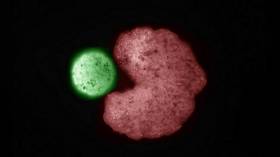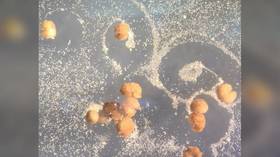Robots are now able to replicate. What does this mean for humanity?
Brendan Heard is an author, op-ed writer, painter, blogger, and designer who has worked in international media. Follow him on Twitter @Trad_West_Art

A team of scientists at the University of Vermont, Tufts University, and Harvard University have created ‘living robots’ (called Xenobots) that can reproduce themselves in an entirely new process of biological propagation. They have recently published the results of their research in the Proceedings of the National Academy of Sciences.
They first successfully created Xenobots in 2020 from embryonic cells of the African clawed frog (Xenopus laevis). But with the aid of artificial intelligence the scientists have recently discovered that these tiny computer-designed organisms can travel, gather cells (loose stem cells) and assemble their own Xenobots inside themselves. After a gestation period of a few days within their ‘mouths,’ the new Xenobots look and behave just like their ‘parent’ – and can also replicate themselves, ad infinitum.
People have thought for quite a long time that we’ve worked out all the ways that life can reproduce or replicate. But this is something that’s never been observed before.(Douglas Blackiston, PhD, senior scientist at Tufts University)
The team was amazed when they saw the AI-designed bio-bots were capable of simple tasks, but they were positively shocked to see they soon found a way to spontaneously reproduce. It would seem that the genome, once freed from the natural design to become a frog, seeks a proactive new way to flourish. A plasticity of routes to survival appears to be coded in the essence of cells themselves. Including, according to the team, a ‘collective intelligence.’
A lead author of the study, Sam Kriegman, PhD, spoke of the profundity of the project: “No animal or plant known to science replicates in this way.”
The project required the assistance of an AI program at UVM’s Vermont Advanced Computing Core. This AI tested billions of body shapes in simulation with an ‘evolutionary algorithm’ in an effort to find a shape that allowed the cells to be more effective at what they call “kinematic” replication, which has only previously been observed at the molecular level, and never before at the cellular. The AI settled on a final shape which apparently resembles the ‘Pac-Man’ video game.
https://youtu.be/aBYtBXaxsOw
“With the right design—they will spontaneously self-replicate,” says Josh Bongard, PhD, a computer scientist at the University of Vermont who co-led the research.
This is the key to what appears to be the greater breakthrough of this experiment: the apparent variance of possibility within simple single cells. Thy will adopt patterns which follow the behavior of more compleex organisms with some simple tweaking (in this case, by instructing the cells to adopt a pac-man mouth). Suddenly they are reproducing. This revelation has significant application to biology, evolution, chemistry, engineering, computer science, and more.
To quote Jurassic Park: ‘life finds a way.’ Or, as is more aptly quoted in the study itself: “life harbors surprising behaviors just below the surface, waiting to be uncovered.”
The possibilities of variation, or the complexity of abilities which is programmable would then seem to be a vast and uncanny new landscape. Bongard says to this effect: “We’ve discovered that there is this previously unknown space within organisms, or living systems, and it’s a vast space.”
So, what else could a Xenobot do, with a simple alteration? What are the applications for us humans?
As usual it is a double-edged sword: the potential positives are significant, but it carries both great promise and great risk. However, the team is hopeful.
Bongard believes that pandemics or ecosystem damage constitute a more worrisome risk than their discovery. He had this to say in reference to the Covid vaccine response: “This is an ideal system in which to study self-replicating systems. We have a moral imperative to understand the conditions under which we can control it, direct it, douse it, exaggerate it... The speed at which we can produce solutions matters deeply. If we can develop technologies, learning from Xenobots, where we can quickly tell the AI: ‘We need a biological tool that does X and Y and suppresses Z,’ — that could be very beneficial. Today, that takes an exceedingly long time.”
He goes on to suggest other applications: “deploying living machines to pull microplastics out of waterways or build new medicines... We need to create technological solutions that grow at the same rate as the challenges we face.”
While it is worrisome to think that humanity and nature are engaged in a problem/solution arms race, it does seem the research could have implications for regenerative medicine. If by this process we can tell cells how to behave, then it may be possible to influence birth defects, traumatic injury, cancer, and aging.
Yet again, the risk is implied. If you wish to seed the ocean with a self-replicating tool to clean up microplastics, can you really ever be 100% sure there will be no unpredictable adverse effect? The introduction of ‘solution-organisms’ has been tried in the past – often having the disastrous effect of the solution being worse than the problem it was intended to fix.
Regardless, what this really means to us is that we have a potential new technology: a biological tool which can be fashioned to a specific task. Personally I do find the prospect exciting, as I am normally one to brashly advocate for ‘mad scientist experimentation’ (I am still waiting for geneticists to bring back the wooly mammoth or the Tasmanian tiger). However, as a science fiction fan I am aware of the flip-side, the problematic possibilities of self-improving or self-creating autonomous machines. Miracle solutions occur very rarely, as nature prefers to bargain, and with every stage of evolution there are new problems and new advantages.
There are a series of hopes the team have associated with this discovery. Whether those designs strike the reader with hope or horror depends on the individual. And, regardless, it is a wonderful insight into the mechanics of creation.
The statements, views and opinions expressed in this column are solely those of the author and do not necessarily represent those of RT.


0 Comments:
Post a Comment
Subscribe to Post Comments [Atom]
<< Home